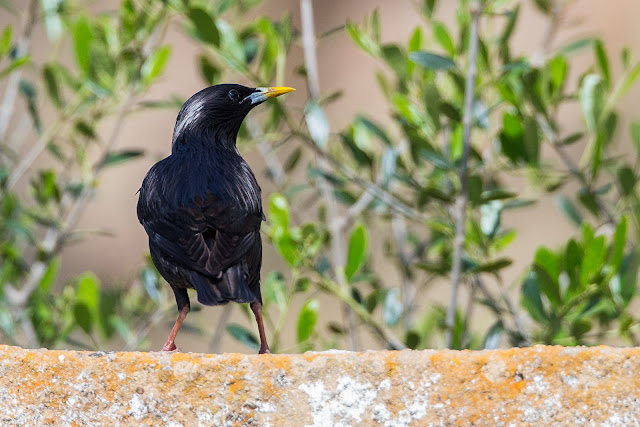We arrived in the early hours of Wednesday the 9th having lost two hours to the change in time zones. We were staying at the Kosta Palace, overlooking the harbour in Kos town. The first morning we explored some of the vegetated areas in the town. I was surprised to see that almost all the swifts around the hotel area were all Common but I was soon watching Pallids which were nesting in decent numbers around the Police building close to the old castle. Having both species in such close proximity during our stay gave a good opportunity to compare the two species in a range of different light conditions. I have previously produced comparative photos of Pallid and Common Swift so won't repeat them here but one thing that struck me this time was how pale-headed Pallid Swift looks when flying towards you.
 |
| Pallid Swift |
 |
| Eastern Olivaceous Warbler |
 |
| Eleonora's Falcon - female 2 upper with blue eye ring and cere and male below with yellow |
 |
| Alikis Lake |
 |
| Curlew Sandpiper |
 |
| Spotted Redshank |
 |
| Little Stint |
 |
| Temminck's Stint |
 |
| upland area around Old Pyli |
This produced a few common woodland species; Coal and Great Tits, Serin and groups of Alpine Swift plus several Eastern Subalpine Warblers and Cretzschmar's Bunting plus a single female Black-eared Wheatear but few raptors. I'd hoped for Bonelli's Eagle and Long-legged Buzzard in the mountains but didn't see either.
Back in the lowlands near Tigaki I came across a pair of Roller which were present in the same area for several days. One of the birds spent most of its time sat on an old street light which wasn't the best background for a photo.
Other birds around the wetland included Squacco and Night Herons, Zitting Cisticola, and around 20 Greater Flamingo plus Yellow-legged Gulls but the only terns I saw were a couple of Sandwich. Ruddy Shelduck were much in evidence at the western end of Alikis lake with about 20 birds present early morning which then moved on to stubble fields to feed. From their behaviour it appeared them at least some were probably breeding there.
Towards the end of our week we drove around the coast from Kos town to Tigaki, we saw at least 5 Lesser Kestrel hunting over the fields and a single female Red-footed Falcon.
 |
| Cretzschmar's Bunting - male |
 |
| Eastern Subalpine Warbler - male |
 |
| Black-eared Wheatear - female |
 |
| Roller |
 |
| Ruddy Shelduck |
Towards the end of our week we drove around the coast from Kos town to Tigaki, we saw at least 5 Lesser Kestrel hunting over the fields and a single female Red-footed Falcon.
 |
| Red-footed Falcon -female |
I visited the Psalidi Wetlands just east of Kos town but apart from a few Wood Sandpiper there were few birds here.
My impression during the week was that the birds didn't change much although Bee-eaters appeared to be moving through.
Aside from the birds we saw Swallowtail and Scarce Swallowtail butterflies and what looked like Small Fiery Copper, Starred Agama, Snake-eyed Skink and Spur-thighed Tortoise
 |
| Lesser Fiery Copper |
 |
| Starred Agama |
 |
| Spur-thighed Tortoise |
Overall I thoroughly enjoyed Kos for a weeks birding with a good variety of habitats and range of species. I'm sure if you were lucky with the weather systems you could see more migrants than I encountered.






















































